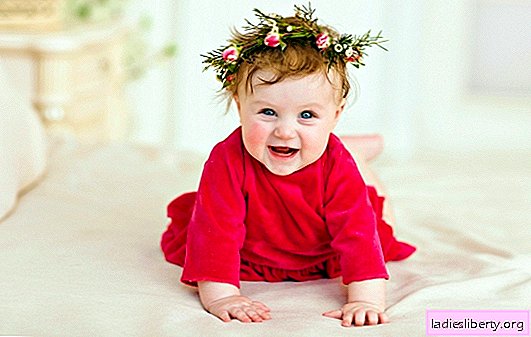
Every adult has fears and phobias. But what do we know about the fears of our children? Where do they come from, how do they appear and what to do with them?
Many questions are dizzying to worried parents, and for good reason, because it is much more difficult for children to cope with their emotions and overcome their fears. The main task of parents is to recognize fear and gradually correct it.
What is childhood fear?
Fear is the body’s natural response to potential danger. Many adults cannot overcome their phobias for many years, let alone children who don’t even understand what they’re experiencing.
Reasons for children's fears
Of course, it is interesting and important to know why the child has fear. By finding out the exact origin of the phobia, you can eliminate the source, thereby weakening children's fear. The most common causes of childhood fears are as follows:
• Fright
The main cause of childhood fears is fear. Children are very impressive, and events from the world of adults can seriously scare a child. For example: an aggressive animal, a loud cry, an attack, a scary movie scene.
• Children's fantasy
Very often, developed children's imagination plays a cruel joke. Any phenomenon not yet understood by the child is immediately completed. The problem is that the ability to fantasize often turns an ordinary situation into a frightening event. For example, sounds at night, shadows on the wall, rustling under the bed.
• Tense family atmosphere
Conflicts between relatives and parents can create many fears. From fear of parents to fear of death. No matter how strange it may sound, you need to quarrel correctly, solving problems through a constructive dialogue, without scaring the child with his negative emotions and methods of getting rid of them.
• Conflict situation in society
Quarrels and frustrations with teachers and educators, counselors, classmates and peers can also give rise to many fears. For example, a child will be afraid of speaking in public.
• Neurosis
Neurosis is a psychological deviation that can appear in a child due to the influence of various factors. A state of neurosis can give rise to fears that are not peculiar to the age of the child and his life situation. In this case, a consultation with a psychologist is necessary.
It is also quite difficult to get rid of fears if there are factors that enhance the development of phobias. Often, the following situations are present in the family:
• The family is afraid of something
• The environment laughs at the child’s fear
• A source of fear is present in a child’s life
• Parents are too strict
• Parents forbid their child to show emotions
• Lack of trust with a child
• Parents restrict peer communication
• There is hyper-custody
How to recognize childhood fear?
It is important to know what the manifestation of children's fear looks like. Many parents do not pay attention to changes in the behavior of the child and consider them age-related. But how do you know children's fear?
Children do not know how to hide emotions, so a child who has a fear can be recognized by the following signs:
• Craving for parents
A child who has a strong fear, tries to be closer to his parents: he constantly goes for family members and is surrounded by adults.
• Trying to hide
If a child hides under a blanket before going to bed, sits in the closet during the game, and, in general, tries to hide all the time, then these are vivid indicators of the presence of childish fear.
• Tearfulness, aggression towards others, whims
If the child became more emotional: tearful, unable to restrain his anger, very moody, then most likely he acquired a phobia.
• Gloomy drawings
Children who have obsessive fear often portray their feelings in a drawing. The creativity of such a child will be in dark colors, with a frightening plot and scary characters. Often, children are afraid of their drawings, trying to hide them: put them in a dark corner or on a distant shelf.
• Nerve manifestations
Children under the influence of fear very often bite their nails, suck a finger, pull their hair, pick their nose, and pull their clothes. There are a lot of such manifestations, and, fortunately, the unnaturalness and specificity of such actions is quite noticeable.
Children do not always talk about their fears, due to a lack of understanding of their feelings and emotions or the difficult situation in the family, but parents who notice a phobia in time will help not only ease the baby's condition, but also prevent fear from progressing.
How to deal with childhood fears?
Children's fear is a complex phenomenon, getting rid of which takes time and effort. So what needs to be done to effectively eliminate the child's phobia:
• Talk
Talking about everything in the world is important and necessary. Thanks to them, you can not only learn about the presence of fear, but also overcome it. Talk with the child about his phobia, ask about her.
• draw
As mentioned earlier, children often draw their fears. Take advantage of this. Let the child draw his fear, and then you can burn, tear or drown the frightening picture in the water. Another good way to deal with fear is to add funny and cute details. Offer the baby to make up the monster’s lips or put on a spider skirt and frightening characters will instantly get a funny and ridiculous look.
• Play the theater
Invite the child to transfer his fear to the scene: take on the role of a monster, get stuck in an invented elevator, walk along an imaginary rope at a height of thousands of meters.
• Compose
Invite your child to compose a fairy tale that is associated with a phobia. The end must be made positive, and frightening characters should be ridiculed as they make up the story.
Can childhood fears be prevented?
Can childhood fears be avoided? Yes, you can, but not all. It should be clearly understood that the child is a member of society, which has certain personality qualities and character traits. It is not necessary to protect him from emotional experiences, because by defeating their fears, children grow up as bold and confident people.
However, some phobias do not bring benefits, and often delay for years, accompanying the baby on the path of growing up. To prevent the appearance of unwanted fears in a child, you must adhere to the following recommendations:
• Maintain a trusting relationship with your child to help him analyze negative emotions and feelings.
• Pay attention to the child and avoid feeling unnecessary
• Encourage communication with peers
• Organize games aimed at combating common childhood fears, the release of negative feelings and emotions
• Do not intimidate the child with what he will face in life (hospital, animals, people)
By following these simple rules, you can protect your child from obsessive fears.
Children's fear is a normal phenomenon that almost everyone experiences. The task of parents is to identify and correct the phobia, not allowing its complications, and the transition to a more adult and conscious age.











